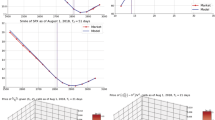Abstract
This paper deals with the superreplication of non-path-dependent European claims under additional convex constraints on the number of shares held in the portfolio. The corresponding superreplication price of a given claim has been widely studied in the literature, and its terminal value, which dominates the claim of interest, is the so-called facelift transform of the claim. We investigate under which conditions the superreplication price and strategy of a large class of claims coincide with the exact replication price and strategy of the facelift transform of this claim. In one dimension, we observe that this property is satisfied for any local volatility model. In any dimension, we exhibit an analytical necessary and sufficient condition for this property, which combines the dynamics of the stock together with the characteristics of the closed convex set of constraints. To obtain this condition, we introduce the notion of first order viability property for linear parabolic PDEs. We investigate in detail several practical cases of interest: multidimensional Black–Scholes model, non-tradable assets, and short-selling restrictions.
Similar content being viewed by others
Notes
A uniform ellipticity condition for σ appears in the statement of this theorem, but this assumption is not used in the proof and indeed is not required.
References
Bensoussan, A., Touzi, N., Menaldi, J.: Penalty approximation and analytical characterization of the problem of superreplication under portfolio constraints. Asymptot. Anal. 41, 311–330 (2005)
Bouchard, B., Chassagneux, J.-F.: Portfolio management under risk constraints. Lectures given at MITACS-PIMS-UBC Summer School in Risk Management and Risk Sharing (2010). arXiv:1307.0230 [math.PR]
Bouchard, B., Chassagneux, J.-F.: Valorisation de Produits Dérivés. Economica, Paris (2014)
Bouchard, B., Chassagneux, J.-F.: Discrete-time approximation for continuously and discretely reflected BSDEs. Stoch. Process. Appl. 118, 2269–2293 (2008)
Broadie, M., Cvitanić, J., Soner, M.: Optimal replication of contingent claims under portfolio constraints. Rev. Financ. Stud. 1, 59–79 (1998)
Buckdahn, R., Quincampoix, M., Rascanu, A.: Viability property for a backward stochastic differential equation and application to partial differential equations. Probab. Theory Relat. Fields 116, 485–504 (2000)
Cheridito, P., Soner, H.M., Touzi, N.: The multi-dimensional superreplication problem under gamma constraints. Ann. Inst. Henri Poincaré 22, 632–666 (2005)
Cvitanić, J., Karatzas, I.: Hedging contingent claims with constrained portfolios. Ann. Appl. Probab. 3, 652–681 (1993)
Cvitanić, J., Karatzas, I., Soner, M.: Backward stochastic differential equations with constraints on the gains-process. Ann. Probab. 26, 1522–1551 (1998)
Cvitanić, J., Pham, H., Touzi, N.: Super-replication in stochastic volatility models under portfolio constraints. J. Appl. Probab. 36, 523–545 (1999)
El Karoui, N., Jeanblanc, M., Shreve, S.: Robustness of the Black–Scholes formula. Math. Finance 8, 93–126 (1998)
El Karoui, N., Peng, S., Quenez, M.C.: Backward stochastic differential equations in finance. Math. Finance 7, 1–71 (1997)
Evans, L.C., Gariepy, R.F.: Measure Theory and Fine Properties of Functions. CRC Press, Boca Raton (1992)
Gobet, E.: Revisiting the Greeks for European and American options. In: Akahori, J., Ogawa, S., Watanabe, S. (eds.) Proceedings of the “International Symposium on Stochastic Processes and Mathematical Finance”, Ritsumeikan University, Kusatsu, Japan, March 2003 pp. 53–71. World Scientific, Singapore (2004)
Karatzas, I., Kou, S.: On the pricing of contingent claims under constraints. Ann. Appl. Probab. 6, 321–369 (1996)
Ma, J., Zhang, J.: Representation theorems for backward stochastic differential equations. Ann. Appl. Probab. 12, 1390–1418 (2002)
McMullen, P.: On the inner parallel body of a convex body. Isr. J. Math. 19, 217–219 (1974)
N’Zi, M., Ouknine, Y., Sulem, A.: Regularity and representation of viscosity solution of partial differential equations via backward stochastic differential equations. Stoch. Process. Appl. 116, 1319–1339 (2006)
Pardoux, E., Peng, S.: Backward stochastic differential equations and quasilinear parabolic partial differential equations. In: Rozovskii, B.L., Sowers, R.B. (eds.) Stochastic Partial Differential Equations and Their Applications. Lecture Notes in Control and Information Sciences, vol. 172, pp. 200–217. Springer, Berlin (1992)
Pham, H.: Continuous-Time Stochastic Control and Optimization with Financial Applications. Stochastic Modeling and Applied Probability, vol. 61. Springer, Berlin (2009)
Rockafellar, R.: Convex Analysis. Cambridge University Press, Cambridge (1996)
Soner, M., Touzi, N.: The problem of superreplication under constraints. In: Carmona, R.A., et al. (eds.) Paris–Princeton Lectures on Mathematical Finance. Lecture Notes in Mathematics, vol. 1814, pp. 133–172. Springer, Berlin (2003)
Author information
Authors and Affiliations
Corresponding author
Additional information
Research supported by the ANR grant LIQUIRISK and the Chair Finance and Sustainable Development.
Appendices
Appendix A: Facelift properties
The first lemma collects some useful properties of the facelift transform. Lemma A.2 is an approximation result, and Lemma A.3 is a (minimal) PDE characterization of the facelift.
Lemma A.1
-
(i)
If h is lower semi-continuous, then so is F K [h].
-
(ii)
If h(x)≥g(x) for all x, then F K [h](x)≥F K [g](x) for all \(x\in\mathbb{R}^{d}\).
-
(iii)
If 0∈K and h( ⋅ )=c with c a given constant, then F K [h]=h.
-
(iv)
F K [h∨g]=F K [h]∨F K [g].
-
(v)
F K [h]≥h and F K [h]=F K [F K [h]].
Proof
Property (i) holds true since F K [h] is the pointwise supremum of lower semi-continuous functions. Properties (ii)–(iv) are obvious consequences of Definition 2.3 of the facelift transform. Property (v) follows from the fact that \(0 \in\tilde{K}\) and from the computation, for any \(x\in\mathbb{R}^{d}\),
□
Lemma A.2
Assume that h is lower semi-continuous and bounded from below by −m h for some m h ≥0. Then there exists an increasing sequence (h n ) n≥1 of bounded Lipschitz functions, uniformly bounded from below by −m h , converging to h and such that F K [h n ]↑F K [h].
Proof
We define the function sequence (g n ) by
It is clear that the sequence (g n ) is nondecreasing, that −m h ≤g n ≤h and that g n is n-Lipschitz-continuous for all n≥1. We now prove that (g n ) converges pointwise to h. Fix some \(x\in \mathbb{R}^{d}\). Since h is lower semi-continuous and bounded from below, there exists a sequence (x n ) in \(\mathbb{R}^{d}\) such that
Since h is bounded from below by −m h , we deduce
so that lim n→∞ x n =x. Together with (A.1) and the lower semi-continuity of h, this yields
Thus, g n (x)↑h(x) as n↑∞, for all \(x \in \mathbb{R}^{d}\).
Define now the function sequence (h n ) by
Since g n is Lipschitz-continuous and bounded from below, h n is bounded and Lipschitz-continuous, for all n≥1. Moreover, since (g n ) is nondecreasing and converges pointwise to h, we also get that (h n ) is nondecreasing and converges pointwise to h. It remains to prove the convergence of F K [h n ] to F K [h]. For any \(x\in\mathbb{R}^{d}\), we simply observe that
□
Lemma A.3
Let h be a lower semi-continuous function from \(\mathbb{R}^{d}\) to \(\mathbb{R}\).
-
(i)
If F K [h] is locally bounded, then F K [h] is a viscosity supersolution of
$$\begin{aligned} \min\{\mathcal{C}_K(\partial_x u), u-h \} = & 0 \qquad\textit {on } \mathbb{R}^d. \end{aligned}$$(A.2) -
(ii)
If v is a differentiable supersolution of (A.2), then
$$\begin{aligned} v(x) \ge& F_K[v](x) \ge F_K[h](x) , \qquad x\in\mathbb{R}^d. \end{aligned}$$In particular, if h is differentiable and ∇h∈K, then F K [h]=h.
Proof
(i) We first recall that since h is lower semi-continuous, so is F K [h] by Lemma A.1. Let \(\bar{x} \in\mathbb{R}^{d}\) and \(\phi \in C^{1}(\mathbb{R}^{d};\mathbb{R})\) be a test function such that
Observe that Lemma A.1(v) implies F K [F K [h]]=F K [h], so that
Using (A.3), we deduce that
In particular, for y=εζ where ε>0 and \(\zeta\in \tilde{K}\) with |ζ|=1, we obtain
Letting ε goes to 0 yields \(\delta_{K} (\zeta) - \partial_{x} \phi(\bar{x} ) \zeta\ge0\). Since ζ is arbitrarily chosen in \(\tilde{K}\), this yields \(\mathcal{C}_{K}(\partial_{x}\phi)(\bar{x})\geq0\).
(ii) Let v be a differentiable supersolution of (A.2). We then have
Fix now \(\bar{x} \in\mathbb{R}^{d}\). We get from the previous inequality that
Therefore, we compute
Taking the supremum over y, we obtain \(v (\bar{x})\ge \mbox {\textsc {F}}_{K}[h] (\bar{x})\).
Suppose now that h is differentiable and [∂ x h]⊤∈K. Since we already know that F K [h]≥h, we conclude that F K [h]=h. □
Appendix B: Proof of Corollary 2.7
For the sake of clarity, let us define \(\tilde{v}^{h}_{K}\) by
Recall the definitions of \(u^{\mbox {\scriptsize \textsc {F}}_{K}[h]}\) and \(u^{\mbox {\scriptsize \textsc {F}}_{K}[h_{n}]}\) in the proof of Theorem 3.1, Sect. 5.2, Step 1 and Substep 2(a) and the fact that
for \((t,x) \in[0,T]\times\mathbb{R}^{d}\). From the left equality of the above statement and Proposition 2.6, we deduce that \(\tilde{v}^{h}_{K}\) is a viscosity supersolution of
Since F K [h n ] is Lipschitz-continuous, it is also well known (see, e.g. [19]) that \(u^{\mbox {\scriptsize \textsc {F}}_{K}[h_{n}]}\) is a viscosity solution of (B.1) for any n≥1. The PDE (B.1) satisfies the assumptions of Theorem 4.4.5 in [20], which provides a strong comparison theorem for viscosity solutions with polynomial growth. Since the functions \(u^{\mbox {\scriptsize \textsc {F}}_{K}[h_{n}]}\) and \(\tilde{v}^{h}_{K}\) have linear growth, this yields
for any n≥1. The proof is concluded by letting n go to infinity. □
Appendix C: Proof of Lemma 4.12
Fix \((t,x)\in[0,T]\times\mathbb{R}^{d}\). We first notice that since γ∈S d , the terminal condition \(\gamma(X^{t,x}_{T}-x)\) can be written as \(\gamma(X^{t,x}_{T}-x)= \partial_{x} \bar{h}(X^{t,x}_{T})\) with \(\bar{h}\) defined by
However, we cannot directly conclude from the H-first order viability of \(\mathcal{L}_{\sigma}u=0\) that Δt,x belongs to H, since the terminal payoff function h does not belong to \(C_{b}^{1}(\mathbb {R}^{d};\mathbb{R})\). We therefore construct a sequence (h p ) valued in \(C^{1}_{b}(\mathbb {R}^{d};\mathbb{R})\) approximating h. Since γn=0, we can write γ=γ ++γ − with two elements γ + and γ − of S d which are respectively nonnegative and nonpositive and satisfy γ + n=γ − n=0.
For all p≥1, define the function h p by
where the functions \(h^{+}_{p}\), \(h^{-}_{p}\) are defined by
for all \(x'\in\mathbb{R}^{d}\). We then easily check that
for all \(x'\in\mathbb{R}^{d}\). Therefore we get from the dominated convergence theorem that
Observe that \(h_{p}\in C^{1}_{b}(\mathbb{R}^{d};\mathbb{R})\) and ∂ x h p is valued in H, for all p≥1. Since the PDE \(\mathcal{L}_{\sigma}u=0\) is first order viable for H, we deduce from Proposition 4.3 that
where (Δp,Λ p) is the solution on [t,T] of the BSDE (4.2) associated to the terminal condition \(\partial_{x} h_{p}(X^{t,x}_{T})^{\top}\). We get from (C.1) and classical estimates on BSDEs that
Since H is closed, (C.2) together with the previous convergence implies that Δt,x is valued in H. □
Rights and permissions
About this article
Cite this article
Chassagneux, JF., Elie, R. & Kharroubi, I. When terminal facelift enforces delta constraints. Finance Stoch 19, 329–362 (2015). https://doi.org/10.1007/s00780-015-0260-4
Received:
Accepted:
Published:
Issue Date:
DOI: https://doi.org/10.1007/s00780-015-0260-4




